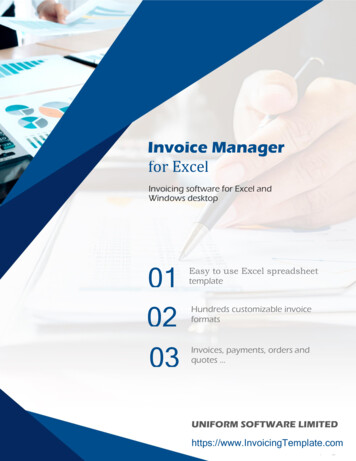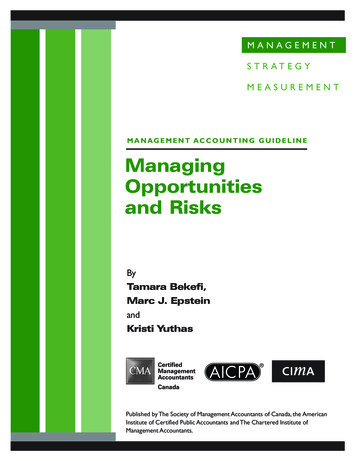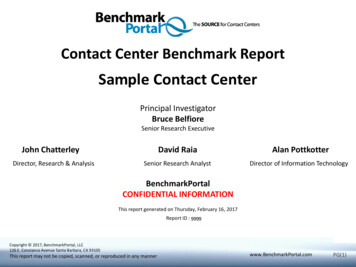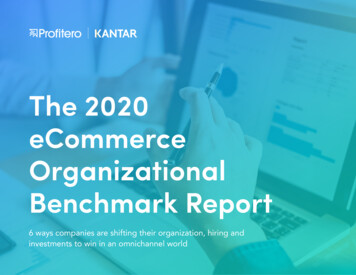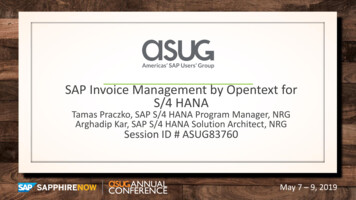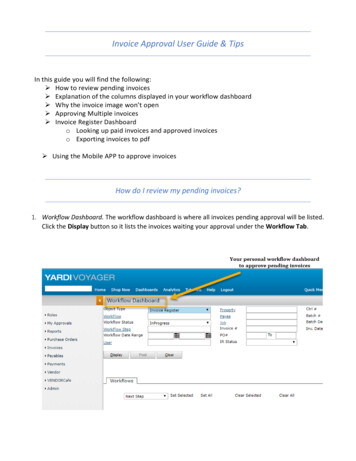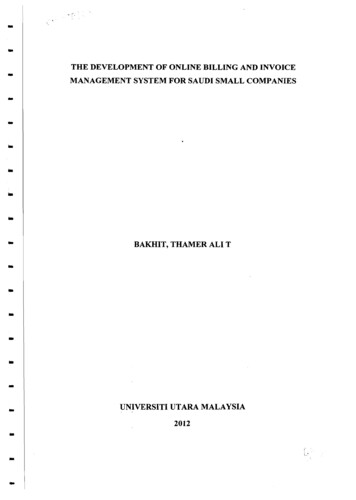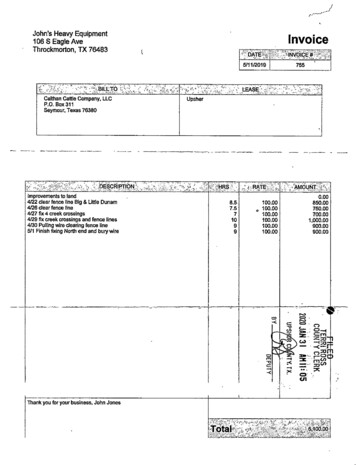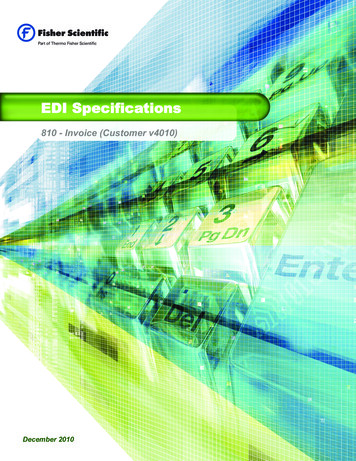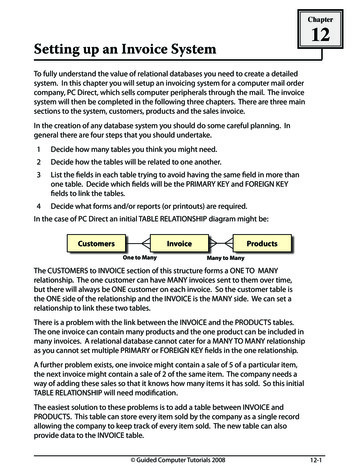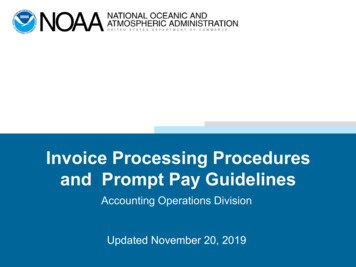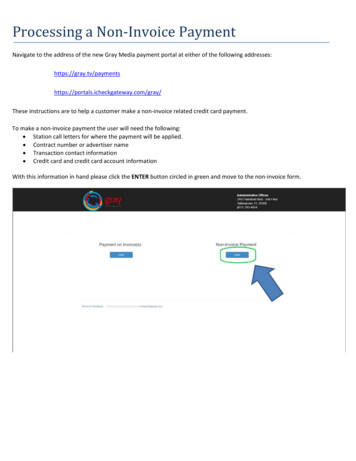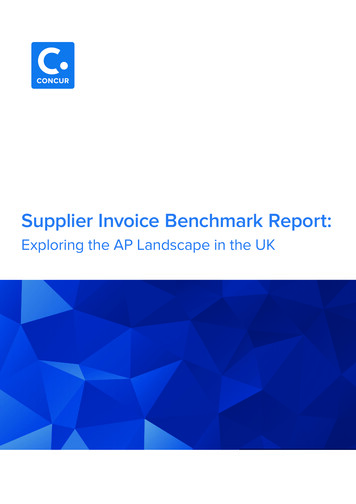
Transcription
Supplier Invoice Benchmark Report:Exploring the AP Landscape in the UK
The role of finance is changing as businesses expectmore direction and insight from their teams. To step upand become a true partner, it’s more important than everfor AP teams to help organisations streamline key internalprocesses and access spend data to support strategicdecision making. This research paper explores the currentstate of supplier invoice procedures in the UK and thechallenges facing a cross section of businesses. We alsoexamine how automation could offer viable solutions.About this reportConcur, together with independent market research specialist VansonBourne, commissioned a study among 500 accounts payable (AP) andfinance professionals throughout the UK in August 2015. The respondentswere spread evenly across business size and sector, with a goal to explorecurrent invoice processes to identify shortcomings and determinebest practices.Survey sample spread by companysize (employees)2Business sector split byrespondents (number)
Executive summaryThere’s a disconnect facing the finance team today. They’re expected tostep up and perform a more strategic role within the business, yet manyof the processes they’re asked to manage are by no means optimised.Owing to these inefficient practices, the accounts payable (AP) teamis often left struggling with mounting piles of paper, the threat of latepayments, errors and duplicated efforts.Some of the key themes the research uncovered in the supplier invoiceprocess are: Outdated procedures, with paper invoices being an established norm. Invoices not making it to the right place. Late payments, which can have dire consequences for supplierrelations. Duplicate and fraudulent invoices, which are occasionally paid. Poor visibility of cash flow and an inability to anticipate spend.The study revealed that roughly 15 employees are tied up in everysingle invoice. Not only that, 63% of companies have actually receiveda duplicate invoice, highlighting a misalignment of processes.What are the key supplier invoice challenges facing your finance team?Businesses of all sizes and sectors are not immune to these stumblingblocks. Understanding the current AP environment and where yourorganisation stands can help with identifying the next steps on yourefficiency journey. After all, nine in ten in the study recognise the valueinvoice automation can bring. Gaining greater control over supplierinvoice workstreams, compliance and cash flow are just some of theways the finance team can establish itself as a trusted advisor tothe business.3This clearly presents a big opportunity – automation can provide thefoundation your business needs and the time to exploit it is now.
01The supplier invoice processin the UK todayThe study overwhelmingly highlights that most organisations are not at apoint where their AP processes are equipped to handle the sheer volumeof supplier invoices coming in. In fact, three in five (59%) respondentsagree their organisations’ invoice process could definitely be improved.On average, a company receives 323 invoices every month handled byaround 15 employees per invoice who are responsible for approvingand processing them. You’d expect with all this allocated resource thatbusinesses could cope with an invoice influx. Yet it’s clear that invoiceprocedures need to be streamlined as a third (34%) of those surveyedadmit their organisation does not process all their supplier invoices in atimely manner.The utilities sector moststruggles to pay supplierinvoices on time and74% think the processcould be improved.Could your organisation’s invoice process be improved?Purchase order practicesThe IT and telecomsindustry is most likely(73%) to have a robustPO process set up.Businesses that process a large number of supplier invoices in a monthcan experience greater control using a purchase order (PO) system. Yetonly around half of the companies surveyed generate POs to kick offthe buying process, while an additional 39% plan to do so in the future.With the exception of small businesses of up to 50 employees, mostrespondents in the study recognise the value of POs.Using POs, companies can easily track the products and services orderedand ensure they match up to what’s received. Invoices are also more likelyto get routed to the right people.When you consider that two in five (38%) respondents say invoicessometimes go to the wrong place in their organisation, it’s evident a POsystem could help remove internal inefficiencies, lost time and delaysin payment.4
Do all your supplier invoices come into one place?Established paper processes2 in 5 say their supplierinvoices sometimes goto the wrong place.The incidence of invoices not making it to the right people is also down topaper processes. Only 43% in the study receive their invoices electronically,suggesting that paper processes are relatively commonplace and alarge number of organisations still send out their invoices by post. This isconsistent across all business sizes.While invoices in the form of PDFs attached to emails are the most typicalform of electronic submission, they’re not foolproof either. There’s noguarantee they’ll make their way to the right recipients or a central inboxand they may fall outside of an efficient AP tool or finance system. In fact,the first thing most employees do is print off their invoices to hand over totheir line manager, so even electronic documents can turn back into paperprocesses.Cheques wereintroduced to the UKover 300 years ago.Surprisingly, paper cheques are still a popular form of payment with two infive (42%) saying their organisations use them. It’s the second most reliedon means of payment only behind BACS (72%). Yet cheques can take upto six days to clear, get misplaced or lost in the post, not to mention the UKgovernment plans to phase them out in 2018.33% of organisations also use CHAPS for same-day payment, indicating theneed for many organisations to resort to this faster, more expensive methodto avoid the consequences of late payments.Companies sized between 1,000-2,999 employees have the highest rate (54%)of invoices going to the wrong place.5
15 people and countingOf those organisations surveyed that have a PO system in place,an average of six people are involved in raising each one. Once aninvoice is submitted, a further six people are involved in the approvalprocess alone with an additional nine people working on processingthe supplier invoice in the backend. Allowing for some crossover ofresponsibilities, a conservative average of 15 people are directlyinvolved in the AP invoice process.In the IT and telecomsindustry, an astounding28 people are typicallyinvolved in approvingand processingsupplier invoices.Raise POsApprove APInvoicesProcess AP InvoicesChasing statusNot only are employees tied up with the invoice process, many find theirtime is consumed by suppliers following up on the status of payment.88% of respondents say their organisation regularly fields calls fromsuppliers chasing updates on payments. In fact, 69% receive these callsat least once a week and sometimes as much as ten times a day. Themajority say it’s difficult to provide their suppliers the answers they’relooking for in the moment.81% of pharmaceuticalsfind it challengingto provide invoiceupdates to suppliers.How difficult is it for your organisation to provide invoice updates to suppliers?6
02The top invoice challengesIt’s clear there’s a lot keeping the finance team up at night when delvinginto specific supplier invoice issues. Seven in ten (71%) have concernsabout their supplier invoice process, with late and duplicate payments topof mind. They’re also worried about internal processes taking too long,fraudulent invoices slipping through the net and not having full visibilityinto their cash flow data. But what concrete consequences are companiessuffering as a result?Large companieswith between 1,0002,999 employees arethe most concerned(59%) about payingduplicate invoices.What are you most concerned about in your current supplier invoice process?Long processes and late paymentsWhen invoices get stuck in approvers’ inboxes, the scope for late paymentsbecomes a reality. Almost eight in ten (78%) respondents admit theirorganisation has paid an invoice late. Aside from the internal inefficienciesincurred as your teams scramble to meet deadlines, the repercussions of latepayments run much deeper, potentially damaging the supplier relationship.Consider that: Nearly 60% have been charged late payment fees. One in five has had a supplier cancel their goods or services and evenrefuse to work with them again.7
58% of those in theutilities sector have beenforced to pay late fees.What consequences has your organisation experienced asa result of late payment?Duplicate and fraudulent invoicesDuplicate invoices are a top concern for many companies. Suppliers may sendinvoices in both print and electronic form and sometimes resend invoices toprompt speedy payment. An astounding 63% of organisations have receiveda duplicate invoice from their suppliers. Not only that, a third (33%) admit toactually having paid one – that they’re aware of. Without an automated systemin place, the chances of receiving them and paying twice for products andservices greatly increases.3 in 5 companieshave received aduplicate invoicefrom their suppliers.Have these occurrences ever happened to your organisation?8
If that wasn’t bad enough, fraudulent invoices are also creeping in, withnearly a quarter (24%) of respondents saying they’ve received an invoicefor products or services that were never provided or ordered in thefirst place.The finance sectorranked the highestas having receivedand actually paid afraudulent invoice.Invisible cash flowIt’s important for the finance team to be able to report on spend to thebusiness. The study revealed that 56% of respondents either can’t forecasttheir cash flow or are only able to provide a rough estimate at any giventime. This indicates that most finance teams are unaware of their supplierinvoice liabilities and find it complex to project spend or trends, let aloneempower employees to access invoice statuses. This invisibility of spend isa poor reflection on the finance team.What’s more, without a robust tool to enable accurate year-end reporting,companies could fall short of auditor requirements. Gaining insight intocash flow is an essential role of the AP team and an added benefit ofimplementing an automated invoice system.Jan Feb Mar Apr May Jun Jul Aug Sep Oct Nov DecRevenueSpendingAre you able to accurately forecast invoice liabilities cash flow?9
03Accounts payable (AP)automation describesthe ongoing effort ofcompanies to streamlinethe invoice process oftheir AP departmentswhose main responsibilityis to review andprocess transactionsbetween the companyand its suppliers.Current AP automation practicesUpon examining supplier invoice automation processes today, 57% of thosein the study don’t automate. 71% have partially automated practices or areplanning to automate in the future.Who automates, who plans to automate and who doesn’t?Automated processes today:1. Logging electronic invoices2. Confirming invoices matchwhat was ordered3. Logging postal ordersWant to automate:1. Confirming invoices matchwhat was received2. Scanning invoices electronically3. Confirming invoices matchwhat was orderedThe AP wish listWhen probing what companies most want to be able to automate,matching invoices to what was ordered and received, electronicallyscanning invoices and automating payment ranks highest. The highlydesired functions reflect what companies already automate or plan tostreamline in the near future.Which supplier invoice automation processes would most benefit your organisation?10
Optical CharacterRecognition (OCR) is atechnology that enablesyou to convert differenttypes of documents,such as scanned paperdocuments, PDF filesor images captured bycamera into editableand searchable data.These are the quick wins that are easy to get right and can make a bigdifference. But when we look to the bottom of the wish list – OCR scanning,alerting approvers when invoices come in and viewing the status of liabilities –a lower value is placed on these processes. If we think back to the challengesfacing organisations, improving these workstreams can solve a lot of the majorconcerns: OCR scanning technology has advanced in leaps and bounds and can now‘read’ invoices and prepopulate required fields in AP systems, requiring lesstime from the finance team to key in data, meaning quicker payments. By alerting the average of 15 employees in a chain as soon as an invoicecomes in, companies can save days and even weeks where invoices wouldusually get stuck in individuals’ inboxes. By being able to check the status of liabilities, employees can quicklyupdate those suppliers who call on a regular basis, as well as accuratelyforecast cash flow.Perceived implementation challengesThere’re a number of reasons companies are hesitant to adopt AP automation:Senior management buy-in, budget restraints and implementation disruptionsare the main causes of concern. Over three quarters (77%) report perceivedchallenges inhibiting invoice automation. Yet most are unaware that thebenefits an automated system can bring far outweigh any costs (an efficient APsystem could pay for itself in a few short months) or the fact that a cloud-basedsolution makes implementation disruptions a non-issue.What are the main challenges to implementing invoice automation in your organisation?11
04The real value AP invoiceautomation can bringEliminating paper processes and moving towards streamlined practices candeliver significant paybacks throughout the supplier invoice chain. The vastmajority in the study recognise the value of having a streamlined AP system inplace with an astounding nine in ten anticipating real benefits from increasedautomation. And those who already automate report reduced operating costs,less time spent on admin and increased productivity in the business – not tomention improved supplier relations.Which benefits has your organisation experienced or anticipated with automation?But many respondents feel their hands are tied due to a lack of managementbuy-in and budget concerns. While AP automation is often considered thedomain of enterprise companies, these challenges equally apply to smalland medium-sized businesses.Yet cloud solutions don’t require on-site installations or huge IT effort, andgetting employees up to speed is remarkably quick. When you’re dealingwith an average of 15 people on every supplier invoice, minimising the scopefor error and delays using streamlined processes can transform the waybusiness is done. Approvers can process invoices straight from their mobiledevices and are no longer kept away from their day jobs, while theAP finance team can process more invoices at a quicker pace.Employees who were unable to provide instant updates on the status oftheir orders now have that information at their fingertips. This reduces churn,not to mention resending of invoices by suppliers. As we’ve seen, duplicateinvoices pose a real threat – not only in terms of actual cash pay-outs, butalso when it comes to the time and effort invested by employees trying torecoup and resolve these issues. An automated system would inevitablyflag duplicate and fraudulent invoices, cutting them out altogether.12
It’s also absolutely essential for businesses to be able to accurately forecastoperational costs for optimised inventory and cash flow management. If youdon’t know what’s going out and when because it’s scattered across yourbusiness in the form of innumerable paper documents, you won’t be able toprovide a holistic picture to the board. Automated technology can give youintelligent insight into an organisation’s outgoing spend so you’re seen as avalued strategic partner within the business.Aligning and automating processes to reduce time and effort wasted at everystage of the invoice process – from receiving, capturing, processing andreporting on invoices – will provide the edge that sets modern UK companiesapart. The technology exists today to be able to better manage your bottomline and progressive companies are leading the charge.05Imagining the idealinvoice processEvery business size and sector can gain huge advantages by incorporatingsupplier invoice efficiency into their current procedures. With the sheeramount of invoices that the average business processes and the number ofemployees involved, it makes sense to introduce technology that helps thebusiness gain greater workforce efficiency and cash flow visibility.Picture a scenario where: Invoices are electronically sent to a central place - no printing, scanning,faxing or copying. The right people are notified at the right time, even on the go. Duplicate and fraudulent invoices are eliminated. Manual steps are reduced as OCR technology automaticallyprepopulates fields into finance systems. Every employee in the chain has instant access to the status of invoices. Approvers are immediately notified and can action invoices in a fewclicks from their mobiles. Payments are made on time using the most advanced methods. Finance has 360 visibility into outgoing invoice spend.13
06Key findings for small tomedium-sized businessesSmall companies (1-49 employees) are the least likely to think that invoiceautomation would benefit them (44%), yet they’re also the most susceptibleto cash flow disruption when being able to predict outgoing AP spend canmake or break the business. 40% don’t raise POs or even plan to. 49% use cheques as the main form of payment.The findings also show that companies between 50-499 employees are notexempt from receiving and even paying duplicate and fraudulent invoicesand are even more likely to do so than large-scale enterprises with 3,000 employees. They’re also the most concerned about disruption caused today-to-day activities by implementing invoice automation.Inefficiencies in processes could be lurking in the background that they’renot even aware of, while increased visibility into liabilities could make a bigdifference. To be taken seriously as they plan to scale for future growth, smallbusinesses need to think about how automation could enable them to usetheir existing resources more effectively.Key findings for largebusinesses and enterprisesWhile companies with 3,000 employees are slightly better off when itcomes to incorporating invoice automation procedures into their financesystems, large companies with 1,000-2,999 employees are struggling tofollow suit and in some cases, even trail behind smaller companies with500-1,000 employees. They’re least likely to issue POs at 36% (even small businesses with1-49 employees trump them). They’re most likely to have invoices sent to the wrong place (54%). A weighty 59% have actually paid a duplicate invoice.A lack of senior management buy-in and budget constraints seem toplague companies in this group the most. On their journey to becomingwell-established enterprise businesses, these companies can learn a lotabout supplier invoice automation from both larger businesses and eventheir mid-sized counterparts. There’s a clear opportunity to embrace moresophisticated, automated procedures.14
About ConcurConcur, a part of SAP, imagines the way the world should work, offeringcloud-based services that make it simple to manage employee spend.By connecting data, applications and people, Concur delivers an effortlessexperience and total transparency into spending wherever and wheneverit happens. Concur services adapt to individual employee preferences andscale to meet the needs of companies from small to large, so they can focuson what matters most.Concur Invoice – Improve manual invoice processes and eliminate paper.Concur Invoice gives you actionable insight into organisatio
Apr 12, 2016 · Owing to these inefficient practices, the accounts payable (AP) team is often left struggling with mounting piles of paper, the threat of late payments, errors and duplicated efforts. Some of the key themes the research uncovered in the supplier invoice process are: Outdated p
